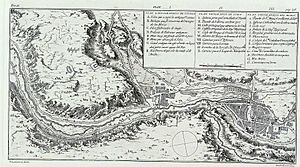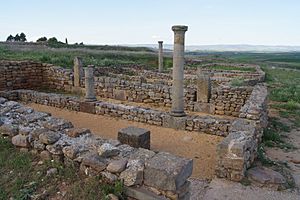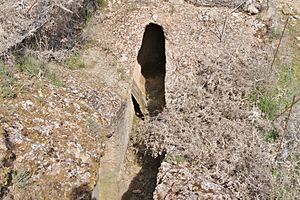Uxama Argaela facts for kids
Uxama Argaela was an ancient city in Spain. It was first built by the Celtiberians, who were people living in ancient Spain. Later, it became a Roman city. You can find its remains on a hill called El Castro. This hill is near the modern town of El Burgo de Osma in Soria, Spain.
Contents
The Story of Uxama Argaela
Uxama Argaela was an important city for the Arevaci people. They were a group of Celtiberians. The city took part in the Celtiberian Wars from 153 to 133 BC. These were big fights against the Romans. Rome finally conquered Uxama Argaela in 99 BC.
Later, the city supported a Roman rebel named Quintus Sertorius. He was fighting against the main Roman government. Because of this, a famous Roman general, Pompey the Great, destroyed the city in 72 BC. But don't worry, it was rebuilt soon after!
Becoming a Roman City
According to ancient writers like Pliny and Ptolemy, Uxama was part of a Roman area called Conventus Iuridicus Cluniensis. This was in the large Roman province of Hispania Tarraconensis.
Under the Roman Emperor Tiberius, Uxama became a Municipium. This meant it had special rights and its own local government. After this, the city grew a lot. New buildings were constructed, like a small forum. A forum was a public square where people met. They also built large homes, city walls, and an area for industries. This industrial area was by the Ucero river.
Visigoth Times
Much later, in the 6th century, the Visigoths ruled this area. Bishops from Uxama attended important meetings. These meetings were called the Councils of Toledo.
What You Can See Today
The ancient city of Uxama covers two flat areas. These areas are about 28 hectares in size. You can still see parts of the old city walls. These walls were protected by rectangular towers. They are visible to the north, east, and south of the city.
Some of the most important things to see are:
- The Mina: This was a section of an ancient drain.
- Cisterns: These were large tanks for storing water.
- Baths: Public bathhouses where Romans would clean themselves.
- A basilica: This was a large public building, often used for law courts. It has mosaics, which are pictures made from small colored pieces.
In an area called Portugui vineyards, archaeologists found a large Celtiberian cemetery. This cemetery had graves where people were cremated. These graves date back to the 3rd and 2nd centuries BC.
You can also see parts of the ancient aqueduct. An aqueduct was a system to carry water. Sections of it were cut right into the solid rock around the city.
Amazing Discoveries
Every summer, archaeologists continue to dig and explore the site. They often work with the nearby ancient site of Tiermes.
There is also a small museum about 2 kilometers from the old fort. It is open only during the summer months. You can find it along the N-122.
Many important objects have been found at Uxama. These discoveries are displayed in several museums. You can see them at the National Archaeological Museum in Madrid. They are also at the Numantine Museum in Soria. Some are even at the National Army Museum in Toledo.
The finds include:
- Sculptures and Roman column tops.
- Iron weapons.
- Inscriptions, which are writings carved into stone or metal.
- Coins from the Roman Republic and the Roman Empire.
- Ceramics (pottery) and glass objects.
- A collection of bronze horse figures.
See also
 In Spanish: Uxama Argaela para niños
In Spanish: Uxama Argaela para niños





